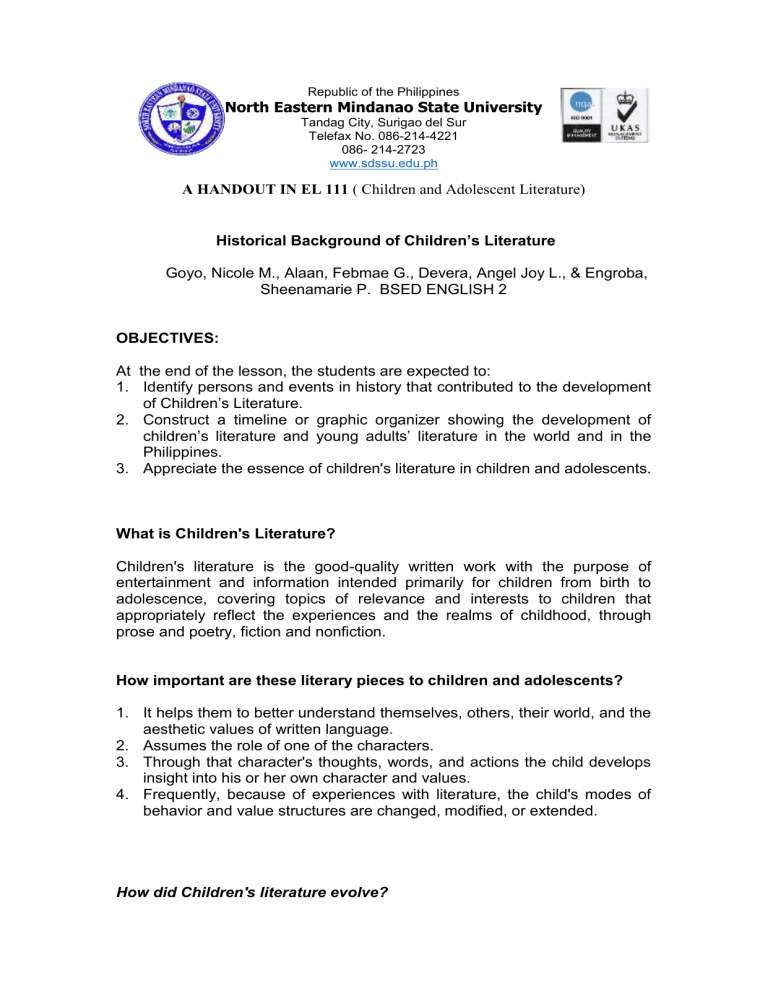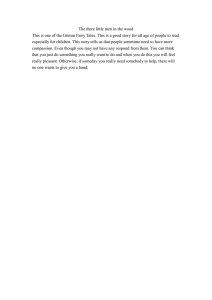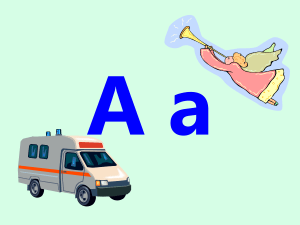
Republic of the Philippines North Eastern Mindanao State University Tandag City, Surigao del Sur Telefax No. 086-214-4221 086- 214-2723 www.sdssu.edu.ph A HANDOUT IN EL 111 ( Children and Adolescent Literature) Historical Background of Children’s Literature Goyo, Nicole M., Alaan, Febmae G., Devera, Angel Joy L., & Engroba, Sheenamarie P. BSED ENGLISH 2 OBJECTIVES: At the end of the lesson, the students are expected to: 1. Identify persons and events in history that contributed to the development of Children’s Literature. 2. Construct a timeline or graphic organizer showing the development of children’s literature and young adults’ literature in the world and in the Philippines. 3. Appreciate the essence of children's literature in children and adolescents. What is Children's Literature? Children's literature is the good-quality written work with the purpose of entertainment and information intended primarily for children from birth to adolescence, covering topics of relevance and interests to children that appropriately reflect the experiences and the realms of childhood, through prose and poetry, fiction and nonfiction. How important are these literary pieces to children and adolescents? 1. It helps them to better understand themselves, others, their world, and the aesthetic values of written language. 2. Assumes the role of one of the characters. 3. Through that character's thoughts, words, and actions the child develops insight into his or her own character and values. 4. Frequently, because of experiences with literature, the child's modes of behavior and value structures are changed, modified, or extended. How did Children's literature evolve? Oral story telling- Before the invention in the fifteenth century of the printing press, which made books more widely available, children listened to stories told by their elders, this in general, states that the characteristics of the earliest children's literature were presented through oral story telling. The stories were about the adventures of the older people. about animals, and imaginary characters. These stones were passed on by word of mouth from generation to generation before they were collected for printing. Classical Period Early Beginnings: History of Children's Literature under Classical World (Greek and Roman) 500 BCE-400 CE All literature began with the ancient art of storytelling. Our ancestors told stories to entertain each other, to comfort each other, to instruct the young in the lessons of living, to pass on their religious and cultural heritage. Storytelling is an integral part of every world culture. In early times, Western civilization has its roots in the cultures of Ancient Greece and Rome, which flourished between about 500 BCE and 400 CE, now known as the Classical period. Greece in the fifth century BCE is in many ways the birthplace of Western culture and so that is where our story begins. In this cradle of democracy and individualism, children grew up with the stories of the Trojan War (from Homer's Iliad) and of the travels of Odysseus (from Homer's Odyssey) and the stories of Jason and the Golden Fleece and the adventures of Hercules. They also knew of the now-famous fables attributed to the slave Aesop, believed to be a teacher, writing to instruct his students in cultural and personal values. With the decline of Greek civilization, the Roman Empire rose to power, but the Romans remained under the long shadow of Greeks, whom they greatly admired. The power of these ancient stories remains with us, and modern writers and illustrators frequently turn to the Greek and Roman myths for inspiration and retelling. The Aesop's fable- Written by a former Greek slave, in the late to mid6th century BCE, Aesop's Fables are the world's best known collection of morality tales. The fables were originally told from person-to-person as much for entertainment purposes but largely as a means for relaying or teaching a moral or lesson. These early stories are essentially allegorical myths often portraying animals or insects e.g. foxes, grasshoppers, frogs, cats, dogs, ants, crabs, stags, and monkeys representing humans engaged in human-like situations (a belief known as animism). Ultimately the fables represent one of the oldest characteristics of human life: storytelling. Some of Aesop's Timeless Fables AngloSaxon Period The Tortoise and the Hare The Dog and Its Reflection The Boy Who Cried Wolf The Wolf in Sheep's Clothing The Ant and the Grasshopper The Farmer and the Viper The Lion and the Mouse The Crow and the Pitcher The Goose That Laid the Golden Eggs The North Wind and the Sun As far back as the Anglo-Saxon Period, monks and other learned men wrote "lesson books" for children. These lesson books were designed for teaching. Aldhelm (640-709) The first man to write lesson books for children. During the AngloSaxon period, Abbot (monk-leader) of Malmesbury there were and bishop of Sherborne. different kinds of stories. Some Collection of Educational Material De Septenario were Epic Compiled by Aldhelm: De Metris poems were about heroes and Enigmatibus their brave deeds, while Ac Pedum Regulis Elegiac poems were more about It contained the meaning and use o feeling sad and Content of the Collection: the number seven in the Bible. thinking about life. Heroic tales showed how It included riddles and puzzles in brave people Latin, which children were asked to were, and solve. Religious stories taught lessons about right and wrong. Folklore stories added excitement with magical beings. These stories were important for keeping traditions alive, teaching people how to behave, and showing what was important to them. Some Stories of Anglo-Saxon Period Beowulf Dream of the Rood The Battle of Maldon The Wanderer The most famous works from this period include Beowulf that became the highest achievement of Old English literature and the earliest European vernacular epic. The Medieval Period By the fifteenth century, books on manners and morals began to appear in England by 1430. One of these was William Caxton's books that published about 1477. Another was “The Babies Boke” which had the subtitles “Manners and Meals in the Olden Time” so this book contained rules of behavior for boys who trained to become knights during the age of chivalry. William Caxton is the first person to introduce printing press in publishing in Westminster. Some of the pieces printed materials during this time: ABC books- Also known as primers were used at the hour of prime as a book of private devotions in the Angelican Church. Henry VIllI had ordered the printing of both Catholic and Protestant primers that contained the alphabet and Christian principles, thus, the term primer came to be applied to all the first books for children in school. Hornbook- The hornbooks, which were not really books, appeared toward the end of the sixteenth century. These were the first books designed for children to handle. The hornbooks were used to teach the alphabet and combinations of letters and to continue religious instruction. Chapbooks- In 1697 Charles Perrault, a Frenchman, published his collection of tales entitled Comtes de Ma Mere L' Oye or Tales of My Mother Goose. Translations of these tales were published separately in as chapbooks in England. These books were called chapbooks because they were sold by itinerant peddlers called chapmen. Some Of Medieval Period Famous Stories Tittle Magic Tree House Book Author Mary Pope Osborne Year Published 1992 Ella Enchanted Gail Carson Levine 1997 Fairy Tale Romance Series Book 1 Melanie Dickerson 2010 The Journal of Tobias Burgess Unknown 20003 Puritan Period In this period the books stressed fear of God, religious instruction and preparation for death. Children read books that interested them although the books were for adults like John Bunyan's Pilgrim's Progress (1678), Daniel Defoe's Robinson Cruse (1714), Jonathan Swift's Gulliver's Travels (1726), Mallory's Death of King Arthur, Reynard the Fox. The tool that is develop during the Puritan Period: New England Primer- A book made especially for the children of the American colonies appeared. It was a small book, about 3 by 4⅐ inches and had about 100 pages. It contained the alphabet, words and syllables for spelling lessons, the Lord's Prayer, catechism, hymns and verses, rhymes for each letter of the alphabet. In 1658, the first illustrated school book appeared which became the first piture book. It was invented by Johann Amos Comenius, Bishop of Moravia and an educator who believed in teaching children by letting them see things with their own eyes. Orbis Sensualum or Orbis Pictus (The World in Pictures). 17th Century and 18th Century Books- In 1715, Dr. Isaac Watts published Divine and Moral Songs for Children, a companion volume to The New England Primer. Some writers consider Isaac Watts as the starting point of the history of children's literature, and "The Cradle Hymn" as the first children's poem. Battledore- This succeeded the hornbook. It was a 4 by 6½ three-leaved cardboard that folded like a pocketbook. It had the alphabet and easy-reading matter that made it popular until 1840. Some Of Puritan’s Period Famous Stories Book Sinners in the Hands of an Angry God Anne Bradstreet's Poems The Bay Psalm Book Of Plymouth Plantation The New England Primer The Pilgrim's Progress Author Jonathan Edwards Year 1741 Anne Bradstreet 1650s Various (New England Puritan) William Bradford Various (New England Puritans) John Bunyan 1640 1651 1660 1678 John Newbery Era John Newbery "The father of children's literature" He conceived the idea of publishing books for the enjoyment and entertainment of children. 1. Little Pretty Pocket Book - The first book that can be truly called a child's book. - It contained a variety of content aimed at engaging and instructing young readers such as... a. b. c. d. e. 2. Short pieces of prose Poetry Instructional content Games Activities aimed at entertaining and educating children. Mother Goose Melody - a collection of nursery rhymes published. Some of Mother Goose Melody Nursery Rhymes Baa Baa Black Sheep Jack’n Jill Humpty Dumpty Three Blind Mice Pussycat Mother Goose Nursery Rhymes- The Newbery firm seems to have derived the name "Mother Goose" from the title of Charles Perrault's fairy tales, Contes de ma mère l'oye (1697; "Tales of Mother Goose"), a French folk expression roughly equivalent to "old wives'' tales. Mother goose rhymes for child development: a. Cognitive- learn alphabet, numbers and counting, b. Aesthetic- nurturing love for sounds and rhythms, and sensitivity to patterns in arts, c. Social and Physical- most rhymes are cooperative play. The Didactic Period Didactic literature presents philosophical, religious, moral, and scientific knowledge and ideas in various imaginative literary genres. Jean Jacques Rousseau (1712-1778) was a French philosopher who started a new philosophy in the education of children. Some stories of Didactic Period Emile History of Sanford and Merton History of the world AUTHORS Jean Jacques Rousseau Thomas Day Peter Parley Jean Jacques Rousseau (1712-1778) was a French philosopher who started a new philosophy in the education of children. His book Emile embodied the philosophy that children be given freedom to develop their natural interests and learn from actual experience. Jean Jacques Rousseau (1712-1778) was a French philosopher who started a new philosophy in the education of children. His book Emile embodied the philosophy that children be given freedom to develop their natural interests and learn from actual experience. The Return of Fairy Tales Old and New The influence of didactic was unable to control permanently children's love for fairy tales. The publication of Grimm's Fairy tales revived the interest for the imaginative stories. Jacob and Wilhelm Grimm collected the old German stories not for the entertainment of children but to record them scientifically for prosperity. These stories were translated into English in 1823 and were called Grimm's Popular Stories. Some stories of Fairy Tales Thumbelina The Nightingale Ugly Ducklings Book of Nonsense Through the Looking Glass Alice in Wonderland Realistic Literature Authors Hans Christian Andersen Edward Lear Lewis Carroll This period was marked with the appearance of stories of boys and girls in simple home situations, stories of adventure, of brave men and women, history and growth of countries, the wonders of nature and science. Famous stories in Realistic Literature Little Women in 1868 Little Women Little MAn Authors Louisa May Alcott References: https://www.google.com/url?sa=t&rct=j&q=&esrc=s&source=web&cd=&ved=2 ahUKEwjekLjrqpiEAxWEnq8BHX8bDw0QFnoECBgQAQ&url=https%3 A%2F%2Fwww.studocu.com%2Fph%2Fdocument%2Fbukidnon-stateuniversity%2Fgeneral-education%2Fel111module-1-l1-historicalbackground-of-childrens literature%2F45137089&usg=AOvVaw0SmyIH_qA_QbU4_Dg9VwZO& opi=89978449 https://youtube.com/watch?v=wjo1Qaq4THc&si=fK0d6ySjIfgUoL4u


